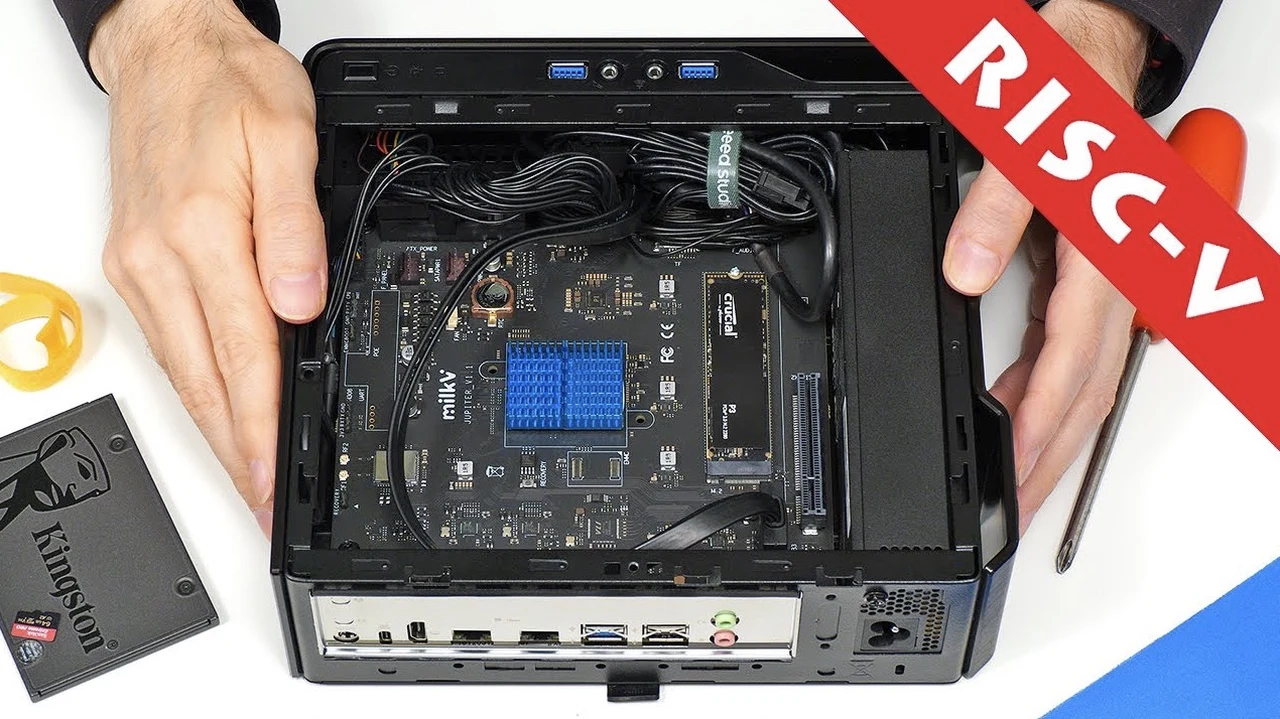
The Milk-V Jupiter heralds a significant leap forward in desktop computing by using the power of RISC-V architecture. This board, powered by the innovative SpaceM M1 system on a chip (SoC), offers a compelling alternative to traditional computing platforms. Available in 4GB, 8GB, or 16GB RAM configurations, it caters to a wide spectrum of performance requirements and budget constraints.
Explaining Computers dives deeper into the features and capabilities of the Milk-V Jupiter, exploring its potential as a . With its SpaceM M1 system on a chip at the helm, this board is not just about raw power; it’s about providing a flexible platform that can grow and evolve with you. With RAM options ranging from 4GB to 16GB, this board is designed to cater to diverse performance needs and budget considerations.
But what truly sets it apart is its seamless blend of connectivity and power options, making it a versatile choice for a wide range of applications. Whether you’re setting up a or crafting a high-performance workstation, the Milk-V Jupiter offers a streamlined assembly process and a tailored operating system to get you up and running with minimal fuss. The Milk-V Jupiter uses RISC-V architecture, offering a Mini-ITX board with 4GB, 8GB, or 16GB RAM options, providing a versatile alternative to traditional computing platforms.
The board features the SpaceM M1 SoC, which enhances performance and power efficiency, making it suitable for demanding applications. Connectivity options include multiple USB ports, HDMI, Ethernet, and PCIe slots, allowing for extensive peripheral and device integration. Assembly and setup are user-friendly, with the installation of (a RISC-V tailored version of Ubuntu) providing a familiar operating environment.
While the board shows strong performance, users may encounter PCI card compatibility challenges, requiring careful testing and adjustments. Upon unboxing the Milk-V Jupiter, you’re greeted with a carefully designed Mini-ITX board featuring the SpaceM M1 chip at its core. This SoC is the linchpin of the board’s performance, striking an impressive balance between power efficiency and processing capabilities.
The board’s layout is intuitive and user-friendly, with clearly labeled components that simplify the assembly and setup process. Key features of the board design include: Compact Mini-ITX form factor for versatile installation options Strategically placed heat sinks for optimal thermal management High-quality PCB material for enhanced durability and signal integrity Clearly marked headers and connectors for easy identification Compared to its predecessor, the SpaceM K1 chip, the M1 delivers , making it suitable for more demanding applications and workloads. The Milk-V Jupiter excels in connectivity options, offering a comprehensive array of ports and interfaces: Multiple USB ports, including USB 3.
0 for high-speed data transfer HDMI output for crisp, high-resolution display support Gigabit Ethernet for fast and reliable network connectivity PCIe slots for expandability and customization This extensive range of connectivity options allows you to connect a wide variety of peripherals and devices, significantly enhancing the board’s versatility. The power supply options are equally flexible, accommodating various configurations to meet different user requirements. This adaptability is crucial for tailoring setups to specific power needs, whether you’re building a low-power home server or a high-performance workstation.
Expand your understanding of RISC-V architecture with additional resources from our extensive library of articles. Assembling the Milk-V Jupiter is a straightforward process, thanks to its user-friendly design. The board’s layout makes fitting components and managing wiring intuitive, even for those with limited experience in computer assembly.
Once the hardware is in place, the next step is installing Bianbu OS, a version of Ubuntu specifically tailored for RISC-V architecture. Key points about the assembly and OS installation: Clear labeling on the board simplifies component placement Standardized connectors ensure compatibility with a wide range of components BianbuBianbu OS provides a familiar environment for users transitioning from other platforms The OS comes pre-configured with essential drivers and software for the Milk-V Jupiter This combination of hardware simplicity and software optimization ensures a , allowing you to get your system up and running quickly. Performance testing of the Milk-V Jupiter demonstrates its capability to efficiently handle various software applications and streaming media.
The SpaceM M1 SoC proves its mettle in tasks ranging from basic productivity to more demanding computational workloads. However, it’s important to note that you might encounter challenges with PCI card compatibility. This is a common issue with emerging architectures and requires careful consideration: Thoroughly research compatibility before purchasing additional PCI cards Be prepared to test and potentially adjust configurations for optimal performance Stay informed about firmware updates that may improve compatibility over time Despite these potential hurdles, the board consistently demonstrates , underscoring its potential as a viable desktop computing platform.
The Milk-V Jupiter serves as a compelling example of RISC-V architecture’s potential in the desktop computing space. Its blend of performance, connectivity, and flexibility positions it as a noteworthy alternative to traditional platforms. As RISC-V technology continues to evolve, it promises even greater capabilities, potentially reshaping the landscape of personal computing.
For enthusiasts, developers, and users seeking a innovative desktop experience, the Milk-V Jupiter stands out as a . It not only offers a glimpse into the future of open-source hardware but also provides a platform for innovation and experimentation in desktop computing. As the RISC-V ecosystem grows, we can anticipate: Increased software compatibility and optimization Enhanced performance in future iterations of RISC-V chips Greater adoption in various computing sectors, from embedded systems to high-performance computing The Milk-V Jupiter is more than just a product; it’s a harbinger of the diverse and open future of computing architectures.
Whether you’re a technology enthusiast, a developer exploring new platforms, or simply curious about alternative computing solutions, the Milk-V Jupiter offers an intriguing glimpse into the potential of RISC-V in desktop computing. Media Credit:.














